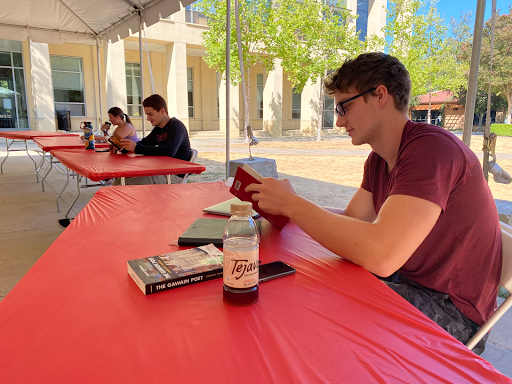This summer, a handful of undergraduate courses opened for in-person learning more than a year after Stanford instructed students to return home, kicking off 17 months of Zoom classes, lectures and office hours.
As students look to transition from their laptop screens to on-campus classrooms this fall, some summer classes have been held in outdoor spaces to account for social distancing guidelines.
One such in-person class, ENGLISH 122C: “Medieval Fantasy Literature,” meets in a courtyard nestled between Lathrop Library and the Knight Building to discuss the history of fantastical literature.
Under a white canopy tent, the eight students in the class sit at individual desks and face a large whiteboard at the front of the makeshift classroom. There they analyze their assigned literature and make connections to readings from other texts for an hour and 20 minutes on Monday and Wednesday afternoons.
“Being in person makes it so much better in terms of how interested I am in what we’re learning,” said Josh Kim ’24, a student enrolled in the in-person course.
He recalled struggling during the winter quarter, which he said was “very difficult.” Kim said that although he was not taking a heavy course load, “the Zoom fatigue started setting in.”
Though he was initially attracted to the Medieval Fantasy Literature course material, Kim said what ultimately convinced him to take the class was that it would be held in person. On June 23, he walked to his classroom for the first time since his senior year of high school. He said he has been able to retain more information in the in-person course in contrast to virtual learning.
The course content also matches well with the outdoor and in-person setting, according to fellow student Jackie Henley ’23. “I feel like I’ve been able to actually make a connection with people in my class, especially because this is such a small class,” she said, adding that she would welcome more in-person seminars with small class sizes if remote lectures become necessary for larger classes.
University spokesperson E.J. Miranda wrote to The Daily that Stanford currently plans to hold the “vast majority” of autumn quarter classes indoors, including large, lecture-based courses.
“The health and safety of our university community remain our top priorities,” Miranda wrote. “We will keep students updated of any changes in protocols.”
For English lecturer Max Ashton Ph.D. ’19, teaching literature in an outdoor discussion seminar has been “idyllic.”
“It was absolutely conducive to more effective and fruitful learning,” he said. “I definitely feel like it is a glimpse of what we’re fighting for when it comes to public health.”
Ashton has even used the setting of the seminar to directly shape the class conversation. Analyzing the class-favorite Arthurian poem “Sir Gawain and the Green Knight,” students continued to circle back to the significance of the central knight’s color. Ashton asked the class which color is most associated with life. He then pointed to the green trees, grass and foliage that surrounded them.
The lecturer also brings his dog Bjarki — named after a Norse hero the students study — to classes regularly as a positive presence for him and his students. Ashton taught virtual classes before this summer and he said that his first on-campus lesson after spending the past year in an entirely digital space was “a bit of a shock.”
He said that he is grateful for the opportunity to connect with his students through spontaneous conversation, which he said was missing at times during his teaching on Zoom.
Ashton said the summer quarter has “made me appreciate just how important that presence is for education, especially in the world of language.”
As the course progressed, Ashton shifted from giving reading quizzes to assigning reflection writing where students can connect texts to other concepts or interesting works. And more recently, class discussions have focused on being student-led.
“The way you see their minds blossom into this body of literature and beyond is a really beautiful thing,” Ashton said of his students.
Kim said that his experience in the class inspired him to pursue a minor in English — and the in-person component played a large role.
As Kim looks forward to fall quarter, he hopes that his courses will be able to fully and safely transition to on-campus classes. While he understands the health concerns of the ongoing pandemic, he said that his engagement in the Medieval Fantasy Literature course has positively benefited his learning in ways that virtual classes could not.
“I am very much aware of how much I’ve been learning and all the texts that I’ve been reading,” he said. “It feels great, and it’s a huge sense of accomplishment, which I haven’t truly felt with Zoom classes.”
